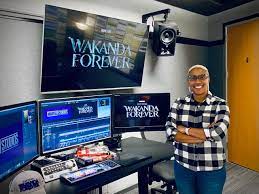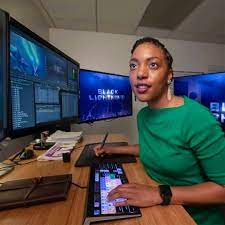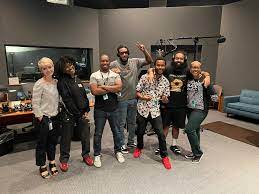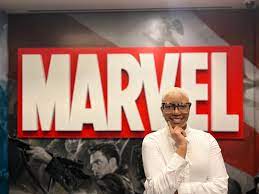By: T. Felder
 Los Angeles, CA (The Hollywood Times) 1/13/23 – Anedra Edwards is one of the VFX (visual effects) editors of Marvel’s Black Panther: Wakanda Forever. As a woman of color, she is breaking down barriers in this male-dominated space, shedding light on the importance of representation. Edwards is persistent and doesn’t let anything stop her from pursuing her passion. She challenges others to take their seat at the table, even if it initially feels uncomfortable. THT had the opportunity to speak with Edwards about her work on the film and how she got her start in the VFX industry.
Los Angeles, CA (The Hollywood Times) 1/13/23 – Anedra Edwards is one of the VFX (visual effects) editors of Marvel’s Black Panther: Wakanda Forever. As a woman of color, she is breaking down barriers in this male-dominated space, shedding light on the importance of representation. Edwards is persistent and doesn’t let anything stop her from pursuing her passion. She challenges others to take their seat at the table, even if it initially feels uncomfortable. THT had the opportunity to speak with Edwards about her work on the film and how she got her start in the VFX industry.
THT: Can you tell us how you got your start as a visual effects editor?
 AE: My first start with a major studio was with the CW Network, under Warner Bros. I was the visual effects editor for the DC Comic show Black Lightning. That was where I got a good taste of visual effects as an editor and working in the superhero space. Regarding my editorial background, I have been in editorial since I was 22. I started in the news as an editor for NBC 4 Washington in DC. I also worked a hefty amount of time in Washinton, DC, in editorial; I worked for Discovery Channel and National Geographic Channel and did some reality as well. And made my move to Los Angeles, where visual effects editorial became an opportunity for me.
AE: My first start with a major studio was with the CW Network, under Warner Bros. I was the visual effects editor for the DC Comic show Black Lightning. That was where I got a good taste of visual effects as an editor and working in the superhero space. Regarding my editorial background, I have been in editorial since I was 22. I started in the news as an editor for NBC 4 Washington in DC. I also worked a hefty amount of time in Washinton, DC, in editorial; I worked for Discovery Channel and National Geographic Channel and did some reality as well. And made my move to Los Angeles, where visual effects editorial became an opportunity for me.
THT: Was it a transition or did you always want to do visual effects?
 AE: Once I came to Los Angeles, it became very present to me. Coming from a smaller city like Washinton, DC, you’re well versed as an editor; you do a bit of everything motion graphics, visual effects, and picture editing. You’re a band of multiple talents, so when I came to Los Angeles, there was a more specific editorial position available to me because you have more studios and bigger studios that can hire for more specific editorial positions, so visual effects became an opportunity coming to Los Angeles I didn’t realize I could do it until I got here. Otherwise, I never thought I could do visual effects specifically, and working for Marvel is just a dream.
AE: Once I came to Los Angeles, it became very present to me. Coming from a smaller city like Washinton, DC, you’re well versed as an editor; you do a bit of everything motion graphics, visual effects, and picture editing. You’re a band of multiple talents, so when I came to Los Angeles, there was a more specific editorial position available to me because you have more studios and bigger studios that can hire for more specific editorial positions, so visual effects became an opportunity coming to Los Angeles I didn’t realize I could do it until I got here. Otherwise, I never thought I could do visual effects specifically, and working for Marvel is just a dream.
THT: From my research I see that VFX is primarily a male dominated industry being an African American woman coming into that space did you find it challenging breaking certain berries or was it a seamless transition?
 AE: It was challenging in some spots. VFX editorial is still growing as a position, especially as more sci-fi and fantasy content becomes available. It was, at one point, very white and very male-dominated. But now you see more inclusivity when hiring for that position. There have been some challenges; first, there were times when I was the only AA woman, the only black person, and the only person of color in certain rooms. Still, I never let that deter me because I was just as qualified as any candidate. I always share that with other people; just because you don’t see somebody like you in those rooms doesn’t mean you are not qualified to be there; use your experience to your advantage as an interesting perspective in your storytelling. That’s why I make sure wherever I go, my voice is heard at whatever seat I have at the table.
AE: It was challenging in some spots. VFX editorial is still growing as a position, especially as more sci-fi and fantasy content becomes available. It was, at one point, very white and very male-dominated. But now you see more inclusivity when hiring for that position. There have been some challenges; first, there were times when I was the only AA woman, the only black person, and the only person of color in certain rooms. Still, I never let that deter me because I was just as qualified as any candidate. I always share that with other people; just because you don’t see somebody like you in those rooms doesn’t mean you are not qualified to be there; use your experience to your advantage as an interesting perspective in your storytelling. That’s why I make sure wherever I go, my voice is heard at whatever seat I have at the table.
THT: In working on The Black Panther: Wakanda Forever I know that you must work with multiple vendors. How did you guys work together to make Ryan Cooglers vision a reality?
AE: It’s a machine working in visual effects for Marvel. There’s a large chunk of departments that must interact with VFX. So, to achieve Ryan’s vision, it’s vital to have focused and detail-oriented people in each spot. I’m part of a team of four VFX editors; we each took pieces we were focused on, even though we all worked on the entire film. It’s great to have as many eyes as you can. Being detail-oriented was a large part of helping Ryan achieve his goals, even down to the point of the types of hieroglyphics that will be shown underwater and what kinds of background extras will be swimming. Keeping great chains of communication was the key to our success.
 THT: You guys did an excellent job. I saw the movie in 4DX, and it was crazy!
THT: You guys did an excellent job. I saw the movie in 4DX, and it was crazy!
AE: Thank You!
THT: How was it working with Michael Ralla?
AE: It was awesome. Working with Michael Ralla he is very cool, and in terms of working from a visual effects house and as well as working on production, he brought that into the film. It was fun to work with him on aerials and doing our drones, especially on our Boston filming, we did a lot of work with him there and Puerto Rico, and desert drones in California. It was good to have a lot of that material to work with, and as a visual effects editor I was responsible for the aerial photography making it to our visual effects houses, visual effects vendors, and creating selects for them; and choosing certain portions of our ariel so that they could either create it in a 3D space or they could use original plate photography, whatever worked best for the VFX artists and their specific programs. So, in working with Michaeal we would sit together and choose takes that best fit. For me as a VFX editor I’m constantly aware where the edit is in different spaces, which comes in handy for our VFX supervisors and producers because they can come and pop into a VFX editing room and they can see where the movie is at any given stage, and we can give them the feedback. We are the middle persons between picture editorial and the rest of the visual effects team.
 THT: Out of all the places and scenes you were responsible for, do you have any favorites?
THT: Out of all the places and scenes you were responsible for, do you have any favorites?
AE: I would have to say Boston, which is where we introduced Riri Williams, and her character of course is going to continue in the MCU (Marvel Cinematic Universe). So, it was fun to be part of her introduction in those scenes and around MIT and Cambridge because we really filmed there. I had never been to Boston, so to work with material driving around and using a chopper for aerials was exciting! We also do something called array cameras which are 120-degree views of several cameras, we used about six cameras in our Boston scenes, and we stitched them together to create a wide panoramic look of video which helps to create the background that viewers will see, and vendors could either create a 3D space or use the original photography. We’re working with six cameras at one time that are either flying or maneuvering on top of cars, so that way we can have that space because sometimes the actors are in front of a blue screen.
THT: Now that you’ve completed Black Panther, what else will you be working on?
 AE: I’m looking forward to staying in the MCU (Marvel Cinematic Universe). It looks like there’s a lot of feature films I will be contributing to. I will definitely keep people posted; I have a couple NDA’s so I can’t talk any further about specific projects. But I’m looking forward to it all.
AE: I’m looking forward to staying in the MCU (Marvel Cinematic Universe). It looks like there’s a lot of feature films I will be contributing to. I will definitely keep people posted; I have a couple NDA’s so I can’t talk any further about specific projects. But I’m looking forward to it all.
THT: What advice would you give women looking to break into the VFX space?
AE: Consider visual effects editorial. We are a bit of a niche position, but it’s something that is becoming essential, especially with the growing demand for feature films like Wakanda Forever. Hopefully, I can put this position on the radar as a VFX editor, it’s fun and something that I really enjoy, it’s a lot of work, but to see the product at the end is really fulfilling. I hope that more women will consider this role and see how essential it is to bring this film to life.
THT: Where can our readers find you?
AE: They can find me on Instagram @anedra_the_editor
Marvel Studios’ Black Panther: Wakanda Forever | Official Trailer





